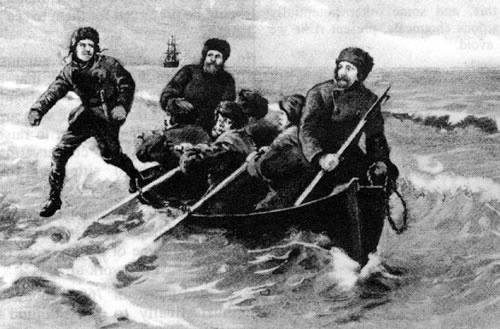The honour of the first step onto the Antarctic Continent is normally credited to Englishman, John Davis, a sealer and captain of the American vessel, Cecilia.

On 7 February 1821 he recorded in his log “…open cloudy weather and light winds a standing for a large body of land in that direction SE at 10 am close in with our boat and sent her on shore ……the land high and covered entirely in snow… I think this southern land to be a continent”.
However, his journal entry is open to interpretation. It seems that the un-named crew of the boat that went ashore were actually the first people to set foot on the Antarctic mainland, where they spent an hour searching for seals, but it is unclear whether Davis joined them.
It would be 74 years before another attempt was made. In 1893, Svend Foyn, a Norwegian shipping magnate funded Henryk Bull, a Norwegian living in Australia, to organise a voyage to find whaling grounds in the Ross Sea.
Carsten Borchgrevink, also a Norwegian settler in Australia, joined the expedition. Borchgrevink would later become famous leading the first expedition to over-winter on the Antarctic mainland (the Southern Cross Expedition, 1898-1900).
On 24 January, 1895, Bull’s ship, the Antarctic, approached the area of Cape Adare. A boat was lowered to take advantage of the good weather and Leonard Kristensen (the captain), Alexander Von Tunzelmann (A 17 year old New Zealander), Carsten Borchgrevink, Henryk Bull, and two or three other crew members made a landing.
Henryk wrote in his journal, ‘I was sitting foremost in the boat, and jumped ashore as the boat struck, saying “I have then the honour of being the first man who has ever put foot on South Victoria Land.”’ So Henryk Bull is sometimes said to be the first confirmed person to step onto the Antarctic mainland.

However, Borchgrevink claimed in a later magazine article that ‘as soon as the order was given to stop pulling the oars, I jumped over the side of the boat… being the first man on shore, and relieving the boat of my weight, thus enabling her to approach land near enough to allow the captain to join ashore dry-shod.’ So does that make Borchgrevink the first?
To add to the confusion the New Zealander, Alexander Von Tunzelmann, maintained that he was in the bow and jumped ashore to steady the boat for Bull to disembark. Up to his death in 1957 Von Tunzelmann maintained that he had been the first ashore.
Perhaps to give Von Tunzelmann’s claim some legitimacy, in 1998, the New Zealand government officially named the place that Von Tunzelmann landed as Von Tunzelmann Point.
So who was the first person to set foot on Antarctica? It probably doesn’t matter but if communication had been better back then it would have made front page news. It was the equivalent of landing on the moon, so remote was the Antarctic continent and difficult to get to.
